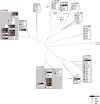Molecular epidemiology of Staphylococcus aureus bacteremia in a single large Minnesota medical center in 2015 as assessed using MLST, core genome MLST and spa typing
- PMID: 28575112
- PMCID: PMC5456361
- DOI: 10.1371/journal.pone.0179003
Molecular epidemiology of Staphylococcus aureus bacteremia in a single large Minnesota medical center in 2015 as assessed using MLST, core genome MLST and spa typing
Abstract
Staphylococcus aureus is a leading cause of bacteremia in hospitalized patients. Whether or not S. aureus bacteremia (SAB) is associated with clonality, implicating potential nosocomial transmission, has not, however, been investigated. Herein, we examined the epidemiology of SAB using whole genome sequencing (WGS). 152 SAB isolates collected over the course of 2015 at a single large Minnesota medical center were studied. Staphylococcus protein A (spa) typing was performed by PCR/Sanger sequencing; multilocus sequence typing (MLST) and core genome MLST (cgMLST) were determined by WGS. Forty-eight isolates (32%) were methicillin-resistant S. aureus (MRSA). The isolates encompassed 66 spa types, clustered into 11 spa clonal complexes (CCs) and 10 singleton types. 88% of 48 MRSA isolates belonged to spa CC-002 or -008. Methicillin-susceptible S. aureus (MSSA) isolates were more genotypically diverse, with 61% distributed across four spa CCs (CC-002, CC-012, CC-008 and CC-084). By MLST, there was 31 sequence types (STs), including 18 divided into 6 CCs and 13 singleton STs. Amongst MSSA isolates, the common MLST clones were CC5 (23%), CC30 (19%), CC8 (15%) and CC15 (11%). Common MRSA clones were CC5 (67%) and CC8 (25%); there were no MRSA isolates in CC45 or CC30. By cgMLST analysis, there were 9 allelic differences between two isolates, with the remaining 150 isolates differing from each other by over 40 alleles. The two isolates were retroactively epidemiologically linked by medical record review. Overall, cgMLST analysis resulted in higher resolution epidemiological typing than did multilocus sequence or spa typing.
Conflict of interest statement
Figures



References
-
- Grundmann H, Aanensen DM, van den Wijngaard CC, Spratt BG, Harmsen D, Friedrich AW. Geographic distribution of Staphylococcus aureus causing invasive infections in Europe: a molecular-epidemiological analysis. PLoS Med. 2010;7(1):e1000215 Epub 2010/01/20. 10.1371/journal.pmed.1000215 - DOI - PMC - PubMed
-
- Kim ES, Kim HB, Kim G, Kim KH, Park KH, Lee S, et al. Clinical and epidemiological factors associated with methicillin resistance in community-onset invasive Staphylococcus aureus infections: prospective multicenter cross-sectional study in Korea. PLoS One. 2014;9(12):e114127 Epub 2014/12/09. 10.1371/journal.pone.0114127 - DOI - PMC - PubMed
MeSH terms
Substances
LinkOut - more resources
Full Text Sources
Other Literature Sources
Medical

